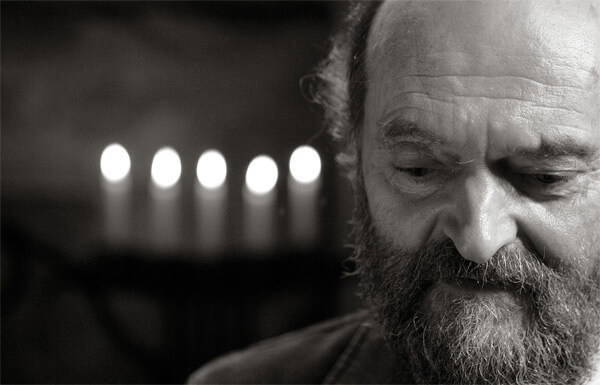 Minimalist music seems a natural fit for setting texts of the Orthodox and Catholic churches. Both have long traditions of contemplation and deliberately repetitive prayers, e.g. litanies, the rosary, and the Jesus prayer. The nature of their liturgies, with their fixed structure and seasonal cycles, also invite worshipers to step outside the sometimes oppressively linear time of modern society and experience a sacred temporality. Moreover, chant and early polyphony seem aesthetically akin to some types of minimalist music.
Minimalist music seems a natural fit for setting texts of the Orthodox and Catholic churches. Both have long traditions of contemplation and deliberately repetitive prayers, e.g. litanies, the rosary, and the Jesus prayer. The nature of their liturgies, with their fixed structure and seasonal cycles, also invite worshipers to step outside the sometimes oppressively linear time of modern society and experience a sacred temporality. Moreover, chant and early polyphony seem aesthetically akin to some types of minimalist music.
Enter Arvo Pärt.

Born in Estonia in 1935, Pärt’s early music often looked to the past. Even as he explored the more prevalent mid-century compositional styles, he would quote earlier composers, such as when Bach’s well-known Prelude in C Major (WTC I) finds its way into Pärt’s Credo (1968). However, In the late 60s and early 70s, Pärt almost completely abandons composing for many years, preferring instead to study chant and polyphony, seeking a new direction for his music. He emerged from this hiatus in 1976, embracing his new tintinnabuli technique as a basis for many of his sacred, minimalist compositions since.
 Creator Spiritus offers a glimpse at Pärt’s music over these decades. The earliest piece, Solfeggio, was written in 1964, predating much of the music for which he is known, but other compositions range from the 1985 Stabat Mater to the more recent Morning Star (2007). Likewise, while much of the music features the exquisite Theater of Voices under the direction of Paul Hillier, there are also two pieces for string quartet, performed by the NYYD Quartet.
Creator Spiritus offers a glimpse at Pärt’s music over these decades. The earliest piece, Solfeggio, was written in 1964, predating much of the music for which he is known, but other compositions range from the 1985 Stabat Mater to the more recent Morning Star (2007). Likewise, while much of the music features the exquisite Theater of Voices under the direction of Paul Hillier, there are also two pieces for string quartet, performed by the NYYD Quartet.
I mention this apparent variety on the disc because despite the range of compositions present, the style is largely unchanging and can grow weary. Now, before you note the astute criticism that is describing a disc of minimalist music redundant, know first that I am an unabashed minimalist, performing the style almost exclusively. I adore minimalist music, but I also know that it is not all the same nor equally interesting. That said, there is some absolutely gorgeous music on this album, but at other times the text setting makes little sense and the compositional approach can become as played out as Philip Glass’ minor thirds.
Two pieces that fall flat are the opening track, Veni Creator (2006) and the centerpiece, Stabat Mater (1985). The former, a setting of a 9th century text invoking the Holy Spirit, is pleasant to listen to, but any connection between the text and music is lost on this reviewer. There are many directions composers can (and have) taken in setting this text, but it seems that Pärt has little to say about this text. By contrast, the dolorous setting of the Stabat Mater, which speaks to the grief of Mary having witnessed the crucifixtion of her son, is moving and beautiful. Unfortunately, Pärt inserts four brief string interludes during this 23-minute piece that seem wholly disconnected from the text. These interludes are downright jaunty, and serve only to disrupt the gorgeous atmosphere that had already been established.
There are, though, some real gems on this disc. Most Holy Mother of God (2003) repeats the phrase “Most Holy Mother of God, save us” seventeen times, but keeps the listener engaged throughout. The piece works because the repetition of the text is common in Orthodox prayer, making it both familiar (or at least plausible) and well suited to Pärt’s style.Yet rather than exact repetition of musical material, Pärt allows the music to ebb and flow, alternating between emphatic solos and homophonic murmurings. It is clear that he has something to say about this text, and the end result works brilliantly. (The rich bass sound the Theater of Voices achieves doesn’t hurt anything, either.)
Another highlight is My Heart’s in the Highlands (2000). Here, a single voice, accompanied beautifully by Christopher Bower-Broadbent on organ, sings this secular text1 entirely on repeated notes, eventually outlining a triad as per the tintinnabuli technique. Here, the repeated notes of the voice effectively express the sorrow of the poem. Moreover, it is so musically convincing that I completely failed to notice that the vocalist was repeating the same pitch until she moved to another note in the triad. It is a beautiful piece magnificently performed.
Still, despite these two tracks, the album remains a mixed bag. I believe that the Theater of Voices has provided a performance that will be difficult to top, but the underlying music remains, at times, tiresome. For those that adore Pärt’s music, this CD will be an absolute must-have; for everyone else, I don’t think this album is capable of winning over new fans.
Theater of Voices, Arvo Pärt: Creator Spiritus (Harmonia Mundi #807553, April 2012)
1. The text is by the Scottish poet Robert Burns (1759-1796), who you may know better for his poem “Auld Lang Syne.”
























